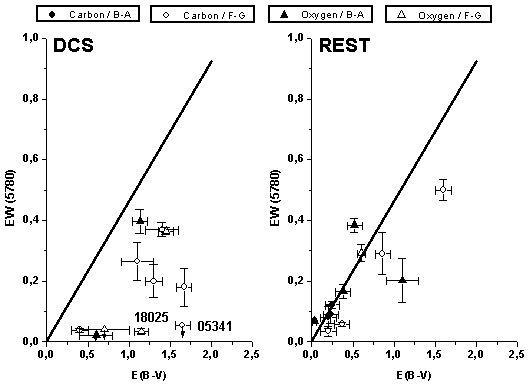The origin of the diffuse interstellar bands is a long-standing observational problem that now can see some light. A systematic survey of post-AGB stars,
conducted by a team
of Spanish and Dutch astronomers, has demonstrated for the first time that the carriers of the diffuse bands cannot be present in circumstellar envelopes.
The result has been highlighted in
Astronomy & Astrophysics journal this week and it indeed places the origin of the diffuse bands in the interstellar medium.
The diffuse interstellar bands are absorption features, showing a broad range of widths and
strengths,
which appear over-imposed on the spectra of bright stars whose lines of sight probe (extra)galactic diffuse-to-dense interstellar clouds.
Currently, more than 200 bands have been identified and catalogued in the spectral range from 3600 to 10200 Å.
Since their discovery, they have been associated to the interstellar medium, most probably to carbonaceous compounds,
but no unambiguous identification has yet been proved.
Since circumstellar shells are sources of replenishment of the interstellar medium, it has been argued that the diffuse interstellar bands may have a circumstellar origin,
either in dense stellar winds or circumstellar shells, thus somehow contravening the name they were initially given.
Observationally, the detection of diffuse bands around evolved stars is hampered by the fact that most of them are losing mass and are usually strongly variable and
surrounded by very cool extended atmospheres where molecules are the dominant source of opacity. These stars are very difficult to model, and diffuse bands are hardly detected
against the forest of features attributed to molecular transitions that appear superimposed on the stellar continuum. This has hampered any systematic search for diffuse bands in evolved stars
in the past. Furthermore, if detected, it is difficult to determine whether the diffuse bands are originating from the interstellar or the circumstellar environment, or even both.
Post-AGB stars are in a short-lived transition phase between the asymptotic giant branch (AGB) and the planetary nebula (PN) stages, evolving while they are still surrounded by the remnant of
the AGB circumstellar shell.
As this evolution takes place, they become hotter very rapidly and the diffuse bands formed in the remnant AGB shell can easily
be detected superimposed on the spectrum of the central star, which no longer shows molecular bands in the optical spectrum.
In addition, post-AGB stars are located in many cases at relative high galactic latitudes and are as such only affected by low interstellar reddening. This facilitates the attribution
of a circumstellar origin to the features observed.
Using the above way to proceed, the astronomers decided to conduct, for the first time, a systematic survey to detect
the circumstellar diffuse bands in a carefully selected sample of post-AGB stars, including stars of various spectral types and chemical composition.
For the analysis, they used some of the
most efficient high-resolution spectrographs in the world, among them, the Utrecht
Echelle Spectrograph (UES) on the William Herschel Telescope, from 1993 to 2003. In some cases, they reutilised data previously obtained for a different scientific purpose.
 |
Equivalent width of the 5780 Å band versus E(B-V) for the group of stars dominated by circumstellar extinction (left panel; DCS type) and for the rest of stars in the sample (right panel) with different
symbols indicating the dominant chemistry and spectral type of the observed stars. The solid line represents the behaviour observed in field stars dominated by interstellar extinction. There is a general trend
for the stars with a dominant circumstellar extinction contribution to show much weaker
diffuse-band strengths compared to the rest of post-AGB stars in the sample. In the most extreme cases, there are stars in this group affected by a large overall extinction in
which surprinsingly some diffuse bands are completely absent, and only upper limits to their equivalent width can be reported. In contrast, a significant number of sources among
the rest of post-AGB stars in the sample show diffuse-band strengths similar to those observed in field stars. This result is in good agrement with the diffuse band carriers
not being present in the circumstellar envelopes of post-AGB stars
[ BMP ].
|
The results showed that the carriers of the diffuse bands do not form, or at least they are not available to produce any detectable spectral feature during the post-AGB phase. The carriers, if present in
the circumstellar envelope of these stars, are not found under the environmental conditions needed to excite the transitions which can be identified as diffuse bands in the interstellar medium.
The radial velocity analysis of the features observed confirmed this result, as the Doppler shifts measured are always found to be consistent with an interstellar origin for the bands observed.
More information:
- R. Luna, N. L. J. Cox, M. A. Satorre, D. A. García Hernández, O. Suárez, and P. García Lario, 2008, "A search for
diffuse bands in the circumstellar envelopes of post-AGB stars", A&A, 480, 133.
- A Hubble Space Telescope image of IRAS 17423-1755 = Hen 3-1475, also known as 'The Garden-Splinker Nebula'. This is one of the post-AGB stars included in this survey that was observed with the UES spectrograph on the
WHT. Credit: European Space Agency, A. Riera and P. Garcia-Lario: http://www.spacetelescope.org/images/html/heic0308a.html.
- An image of IRAS 16594-4656, also known as 'The Water Lily Nebula' in the constellation of Ara.
This is another post-AGB star included in this survey. This image was taken using
the Wide Field Planetary Camera on the Hubble Space Telescope. Credit: Sun Kwok, Bruce Hrivnak and Kate Su: http://sci.esa.int/science-e/www/object/index.cfm?fobjectid=12848.



